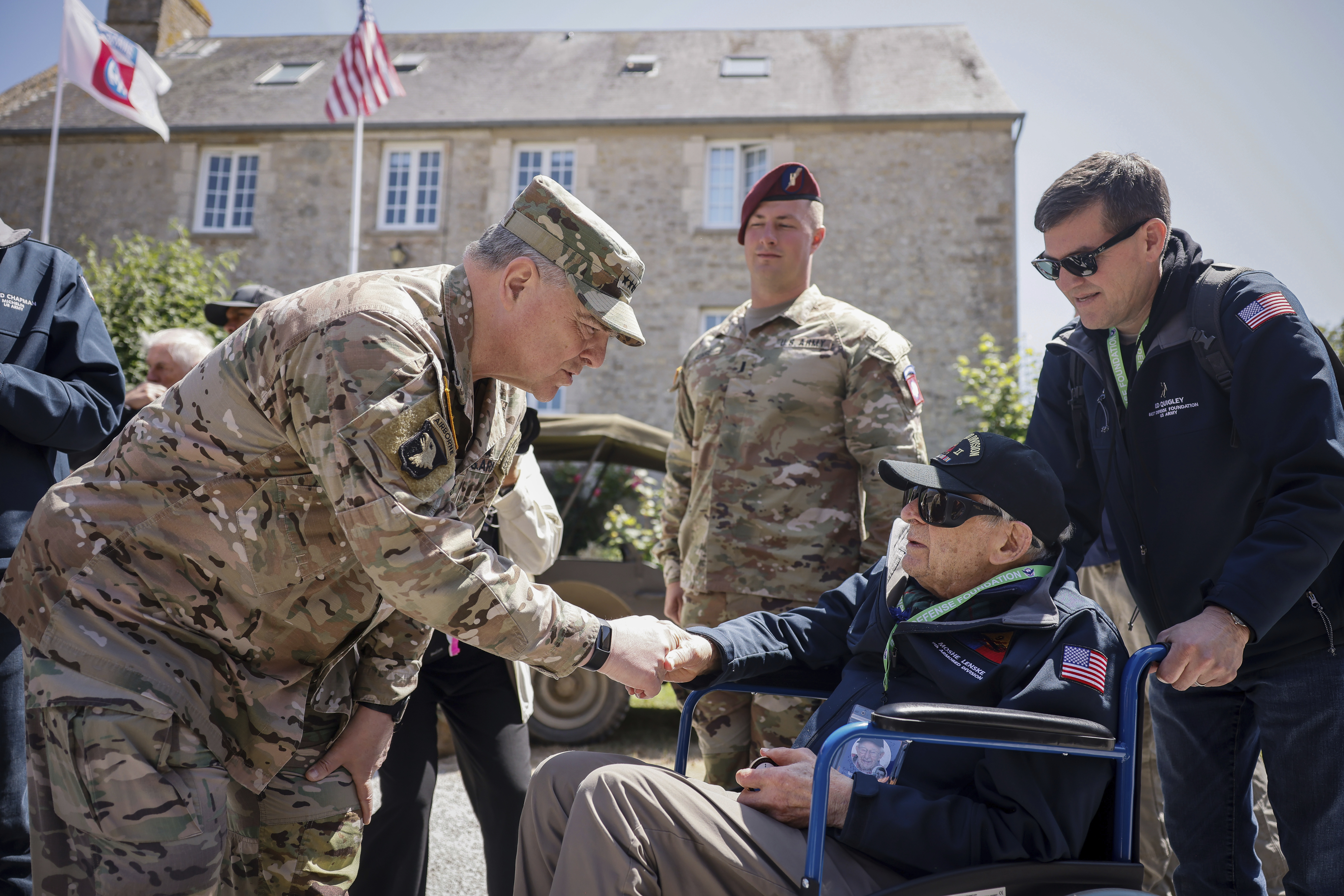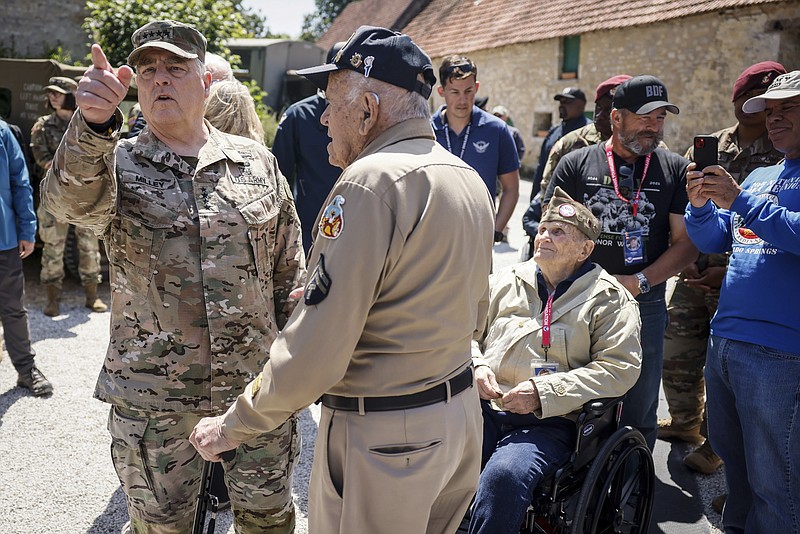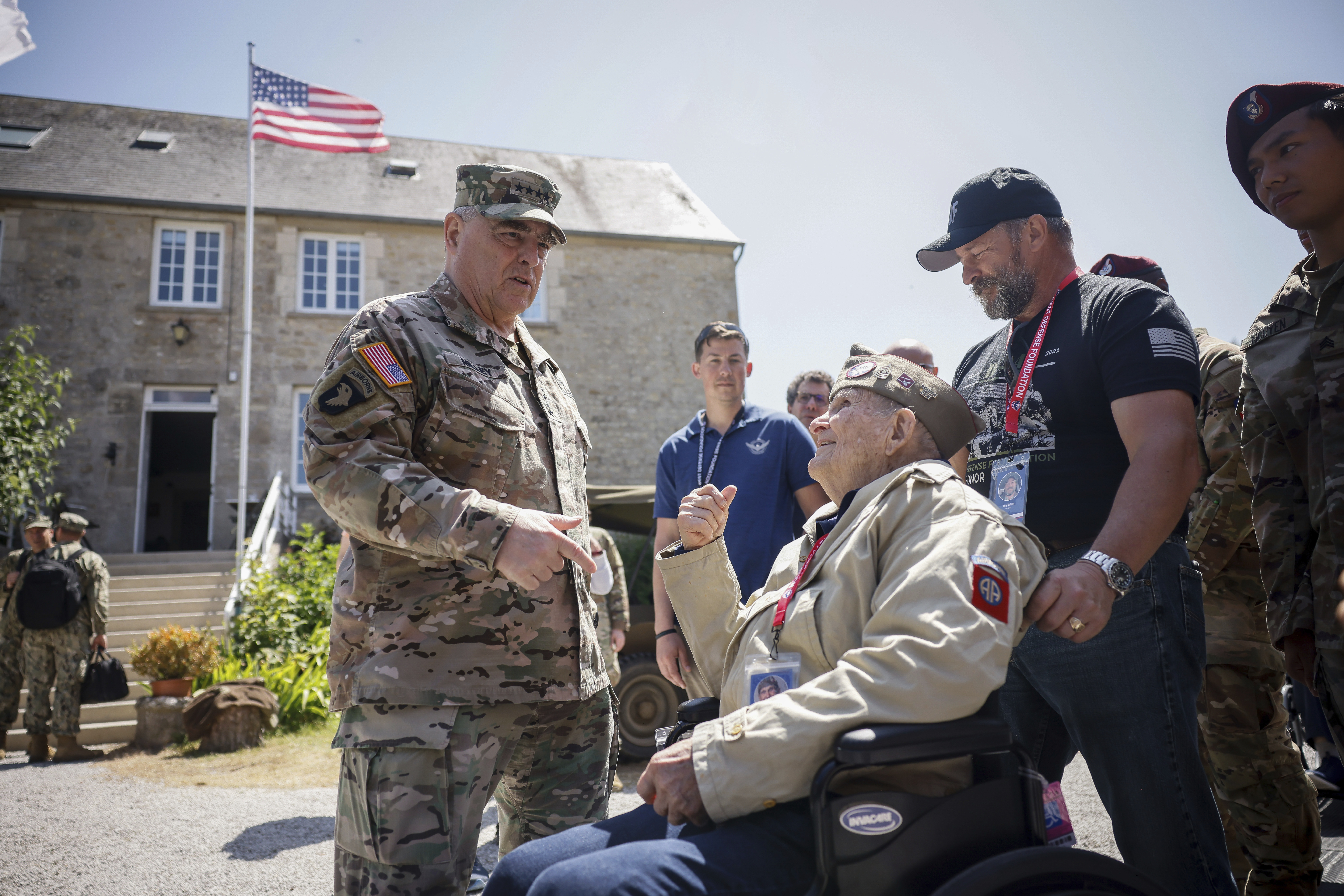AMERICAN CEMETERY, Normandy, France -- U.S. Joint Chiefs chairman Gen. Mark Milley said Tuesday that fighting in Ukraine has increased, but he cautioned against reading too much into each day's operations.
"There's activity throughout Russian-occupied Ukraine and fighting has picked up a bit," Milley said in an exclusive interview with The Associated Press at the American Cemetery in Normandy, France -- the final resting place of almost 9,400 troops who died 79 years ago during the allied D-Day invasion on June 6, 1944.
Milley said it was up to Ukraine to announce whether its counteroffensive campaign has formally begun, but he said Ukrainian troops are ready for this fight.
"It's our estimation that the Ukrainian military is well prepared for whatever they do -- they choose to fight in the offensive fight or in the defense," he said. "They're well-prepared."
But he also warned that as time goes on the fighting will vary.
"Like the Battle of Normandy or any other major battle, warfare is a give and take," Milley said. "There will be days you see a lot of activity and there will be days you may see very little activity. There will be offensive actions and defense actions. So this will be a back-and-forth fight for a considerable length of time."
The U.S. and allies and partners have been pouring billions of dollars in military weapons into Ukraine and have set up a wide range of combat training so Kyiv's forces can maintain that equipment and prepare for the long-anticipated counteroffensive.
Milley spoke as Ukrainian forces are widely seen to be moving forward with a new surge of fighting in patches along more than 600 miles of front line in the east and south. The troops were moving to end what has been a winterlong battlefield stalemate and punch through Russian defensive lines in southeast Ukraine after 15 months of war.
The surge in fighting comes after a long winter of preparation. Nearly weekly at times, the U.S. and allies pumped millions of rounds of artillery and other ammunition into Ukraine, along with increasingly lethal air defense systems, including Patriot missile batteries, tanks, drones and other weapons.
Looking back over the past year, Milley said Ukrainian forces defended their country well from the start of the invasion in February through the middle of the summer, and then did two successful offensive operations in Kharkiv and Kherson. Milley said he believes the training and weapons supplied by the allies over the winter have prepared Ukraine for the coming fight.
"A lot of training went into that, a lot of supplies, a lot of ammunition was provided by other countries to include the United States," Milley said. "They've been training now we think pretty well in combined arms operations. So I think they're prepared for what they think they need to do, no matter what type of operation they run."
Standing in front of rows of white crosses at the cemetery, Milley spoke just a few minutes after he and other top U.S. and allied military leaders laid wreaths and saluted the gathering of the last surviving World War II veterans attending the ceremony. The veterans, some of whom had stormed Omaha Beach, were almost all in their late 90s. But as taps played, many rose from their wheelchairs to stand for the tribute.
Reflecting on their fight, Milley said there is a thread of similarity in the wars.
"You can't really compare that campaign to what's happening in size and scale and scope ... in Ukraine. But the purpose is very similar, which is the Ukrainians, obviously, their objective is to liberate the Russian-occupied Ukraine," Milley said.
DAM COLLAPSES
A major dam in southern Ukraine collapsed Tuesday, flooding villages, endangering crops and threatening drinking water supplies as both sides in the war scrambled to evacuate residents and blamed each other for the destruction.
Ukraine accused Russian forces of blowing up the Kakhovka dam and hydroelectric power station, which sits on the Dnieper River in an area Moscow has controlled for more than a year. Russian officials blamed Ukrainian bombardment in the contested area, where the river separates the two sides.
It was not possible to reconcile the conflicting claims.
Russian and Ukrainian officials used terms like "ecological disaster" and "terrorist act" to describe the torrent of water gushing through the broken dam and beginning to empty an upstream reservoir that is one of the world's largest.
Ukrainian President Volodymyr Zelenskyy called it "the largest manmade environmental disaster in Europe in decades." U.N. Secretary-General Antonio Guterres called it "another devastating consequence of the Russian invasion of Ukraine."
As homes, streets and businesses flooded, authorities expressed concerns about drinking water supplies and emergency crews evacuated thousands of people from Ukrainian and Russian-controlled areas.
In the downstream city of Kherson, angry residents cursed as they tried to preserve their pets and belongings. A woman who gave her name only as Tetyana waded through thigh-deep water to reach her flooded house and rescue her dogs. They were standing on any dry surface they could find but one pregnant dog was missing. "It's a nightmare," she kept repeating, declining to give her full name.
Russian and Ukrainian authorities brought in trains and buses to move residents to safety. About 25,000 people in Russian-controlled areas and 17,000 in Ukrainian-held territory should be evacuated, Ukraine's deputy chief prosecutor Viktoriia Lytvynova said on Ukrainian television. Neither side reported any deaths or injuries.
A satellite photo Tuesday morning by Planet Labs PBC analyzed by The Associated Press showed more than 1,900 feet missing from the wall of the 1950s-era dam.
The dam break, which both sides long feared, added a stunning new dimension to Russia's war, now in its 16th month. Ukrainian forces were widely seen to be moving forward with a long-anticipated counteroffensive in patches along more than 621 miles of front line in the east and south.
It was not immediately clear why either side might destroy the dam, and its collapse might have resulted from gradual degradation. Both Russian-controlled and Ukrainian-held lands were at risk.
Russian Defense Minister Sergei Shoigu charged that Ukraine destroyed the dam to prevent Russian attacks in the Kherson region after what he alleged was a failed Ukrainian counteroffensive. He claimed Ukraine had lost 3,715 troops and 52 tanks since Sunday, and -- in a rare acknowledgment of Russia's own losses -- said 71 Russian troops were killed and 210 wounded. Ukraine followed its standard practice of not commenting on its casualties.
Zelenskyy told reporters his government knew last year that Russia had mined the dam, so "there may come a moment when an explosion occurs." Other Ukrainian officials believe Russia blew up the dam to hinder Kyiv's counteroffensive, even though observers note that crossing the broad Dnieper would be extremely challenging. Other sectors of the front line are more likely avenues of attack, analysts say.
Nigel Gould-Davies, a senior fellow for Russia and Eurasia at the International Institute for Strategic Studies, called the alleged Russian destruction of the dam "a profoundly defensive measure" showing "the lack of confidence in Russia's longer-term prospects" in the war.
Experts have previously said the dam was in disrepair, which could also have led to the breach. David Helms, a retired American scientist who has monitored the reservoir, said in an email that it wasn't clear if the damage was deliberate or simple neglect by occupying Russian forces.
But Helms also noted a Russian history of attacking dams.
Underscoring the global repercussions, wheat prices jumped 3% after the collapse. It's unclear whether the surge was caused by a real threat of floodwaters destroying crops. Ukraine and Russia are key global suppliers of wheat, barley, sunflower oil and other food to Africa, the Middle East and parts of Asia.
Authorities, experts and residents have been concerned for months about water flowing through -- and over -- the Kakhovka dam. After heavy rains and snowmelt last month, water levels rose beyond normal, flooding nearby villages. Satellite images showed water washing over damaged sluice gates.
Zelenskyy alleged that Russian forces set off a blast inside the dam structure at 2:50 a.m. and said about 80 settlements were in danger.
Kremlin spokesman Dmitry Peskov called it "a deliberate act of sabotage by the Ukrainian side" aimed at cutting water to Crimea.
White House National Security Council spokesman John Kirby told reporters the U.S. "cannot say conclusively what happened" and declined to assess the impact on Ukraine's counteroffensive.
At an emergency meeting of the U.N. Security Council later in the day, the U.S. deputy ambassador offered no clarity about what Washington sees as the cause of the dam's collapse, while the Russian and Ukrainian ambassadors traded blame.
Both sides warned of a looming environmental disaster from polluted waters partly caused by oil leaking from the dam's machinery and farmland deprived of irrigation.
Ukraine's Interior Ministry urged residents of 10 villages on the Dnieper's western bank and parts of the city of Kherson to gather essential documents and pets, turn off appliances and leave.
U.N. humanitarian chief Martin Griffiths told the Security Council that at least 40 settlements in the Kherson region were already flooded.
The Russia-installed mayor of Nova Kakhovka, which had a prewar population of about 45,000, said the city was being evacuated.
The Zaporizhzhia nuclear power plant, Europe's biggest, relies in large part on water from the dam's now-emptying reservoir. The U.N.'s International Atomic Energy Agency reported "no immediate risk to the safety of the plant," whose six reactors have been shut down for months but still need water for cooling. It said the rate of the drop in the dam's reservoir level increased from 2 inches to 3.5 inches an hour and could be depleted in a couple of days. The plant has alternate water sources that can last for months, according to the IAEA.
Ukrainian authorities have previously warned that the dam's failure could unleash a volume of water estimated as nearly equivalent to that of the Great Salt Lake in the U.S state of Utah.
Mykhailo Podolyak, a senior adviser to Zelenskyy, warned that "thousands of animals and ecosystems will be destroyed."
The incident also drew international condemnation, including from German Chancellor Olaf Scholz and NATO Secretary-General Jens Stoltenberg, who said the "outrageous act ... demonstrates once again the brutality of Russia's war in Ukraine."
Ukraine controls five of the six dams along the Dnieper, which runs from its northern border with Belarus down to the Black Sea and is crucial for the country's drinking water and power supply and that of Russian-occupied Crimea.
Ukraine and Russia have previously accused each other of attacking the dam.
Information for this article was contributed by Tara Copp, Vasilisa Stepanenko, Susie Blann, Danica Kirka and Edith M. Lederer of The Associated Press.
 U.S Joint Chiefs of Staff chairman Gen. Mark Milley salutes during a ceremony to mark the 79th anniversary of the assault that led to the liberation of France and Western Europe from Nazi control, at the American Cemetery in Colleville-sur-Mer, Normandy, France, Tuesday, June 6, 2023. The American Cemetery is home to the graves of 9,386 United States soldiers. Most of them lost their lives in the D-Day landings and ensuing operations. (AP Photo/Thomas Padilla)
U.S Joint Chiefs of Staff chairman Gen. Mark Milley salutes during a ceremony to mark the 79th anniversary of the assault that led to the liberation of France and Western Europe from Nazi control, at the American Cemetery in Colleville-sur-Mer, Normandy, France, Tuesday, June 6, 2023. The American Cemetery is home to the graves of 9,386 United States soldiers. Most of them lost their lives in the D-Day landings and ensuing operations. (AP Photo/Thomas Padilla) U.S Joint Chiefs of Staff chairman Gen. Mark Milley delivers a speech during a ceremony to mark the 79th anniversary of the assault that led to the liberation of France and Western Europe from Nazi control, at the American Cemetery in Colleville-sur-Mer, Normandy, France, Tuesday, June 6, 2023. The American Cemetery is home to the graves of 9,386 United States soldiers. Most of them lost their lives in the D-Day landings and ensuing operations. (AP Photo/Thomas Padilla)
U.S Joint Chiefs of Staff chairman Gen. Mark Milley delivers a speech during a ceremony to mark the 79th anniversary of the assault that led to the liberation of France and Western Europe from Nazi control, at the American Cemetery in Colleville-sur-Mer, Normandy, France, Tuesday, June 6, 2023. The American Cemetery is home to the graves of 9,386 United States soldiers. Most of them lost their lives in the D-Day landings and ensuing operations. (AP Photo/Thomas Padilla) U.S. Gen. Mark Milley, left, shakes hands with Tec4 Moshe D. Lenske during a gathering in preparation of the 79th D-Day anniversary in La Fiere, Normandy, France, Sunday, June 4, 2023. The landings on the coast of Normandy 79 year ago by U.S. and British troops took place on June 6, 1944. (AP Photo/Thomas Padilla)
U.S. Gen. Mark Milley, left, shakes hands with Tec4 Moshe D. Lenske during a gathering in preparation of the 79th D-Day anniversary in La Fiere, Normandy, France, Sunday, June 4, 2023. The landings on the coast of Normandy 79 year ago by U.S. and British troops took place on June 6, 1944. (AP Photo/Thomas Padilla)
